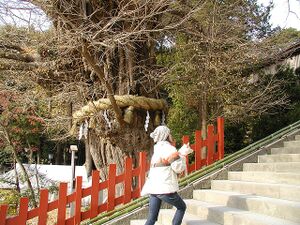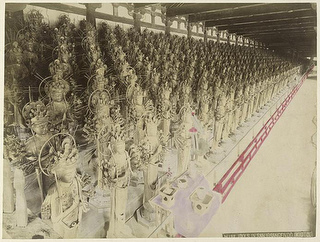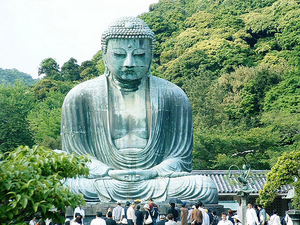Difference between revisions of "Kamakura period"
| Line 16: | Line 16: | ||
Though the Minamoto clan founded the Kamakura shogunate, and the city, its control of the shogunate lasted only very briefly. After the first shogun, [[Minamoto no Yoritomo]], died in [[1199]], his widow [[Hojo Masako|Hôjô Masako]] named her father [[Hojo Tokimasa|Hôjô Tokimasa]] regent (''[[shikken]]''), and seized control over the shogunate. For the remainder of the period, the shoguns were largely pawns, or puppets, of the Hôjô, who exercised true political power. After the third Kamakura shogun, [[Minamoto no Sanetomo]], was assassinated in [[1219]], the Minamoto line of shoguns ended, and for the remainder of the period, Imperial princes and members of the court aristocratic [[Kujo family|Kujô family]] served as shogun. | Though the Minamoto clan founded the Kamakura shogunate, and the city, its control of the shogunate lasted only very briefly. After the first shogun, [[Minamoto no Yoritomo]], died in [[1199]], his widow [[Hojo Masako|Hôjô Masako]] named her father [[Hojo Tokimasa|Hôjô Tokimasa]] regent (''[[shikken]]''), and seized control over the shogunate. For the remainder of the period, the shoguns were largely pawns, or puppets, of the Hôjô, who exercised true political power. After the third Kamakura shogun, [[Minamoto no Sanetomo]], was assassinated in [[1219]], the Minamoto line of shoguns ended, and for the remainder of the period, Imperial princes and members of the court aristocratic [[Kujo family|Kujô family]] served as shogun. | ||
| − | The shogunate survived a conflict with the Imperial court [[1221|two years later]], known as the [[Jokyu War|Jôkyû War]], asserting and defending its power to interfere in the Imperial succession. By the end of the 13th century, the Imperial succession had split and alternated between two lines, the [[Daikakuji and Jimyoin lines|Daikakuji and Jimyôin lineages]]. The tension between these two lines increased after [[ | + | The shogunate survived a conflict with the Imperial court [[1221|two years later]], known as the [[Jokyu War|Jôkyû War]], asserting and defending its power to interfere in the Imperial succession. By the end of the 13th century, the Imperial succession had split and alternated between two lines, the [[Daikakuji and Jimyoin lines|Daikakuji and Jimyôin lineages]]. The tension between these two lines increased after [[1287]], when the shogunate interfered again in the Imperial succession, demanding that [[Emperor Go-Uda]] (of the Daikaku-ji line) abdicate the throne in favor of his cousin [[Emperor Fushimi]] (of the Jimyô-in line), against the wishes of Retired [[Emperor Kameyama]] (of the Daikaku-ji line). This eventually led to the collapse of the shogunate as [[Emperor Go-Daigo]] fought to regain fuller control over the succession, and over governance in general, in the [[Genko War|Genkô War]] of the 1330s. |
==Economics== | ==Economics== | ||
Latest revision as of 15:40, 31 March 2025


The Kamakura period was the period during which the Kamakura shogunate ruled from the city of Kamakura, in the Kantô region.
The period is generally said to begin in 1185 with the Minamoto clan victory in the Genpei War, marking the end of the Taira clan's political control; others cite 1192 as marking the beginning of the Kamakura period, as this was the year in which the Kamakura shogunate was officially established, ending the period of Kyoto (aka Heian) being the sole center of authority. The period ends in 1333, with the fall of the Kamakura shogunate.
Politics
The Kamakura period marks a significant stage in the development of samurai rule. While the Taira clan held considerable power from the 1150s-1180s, they did so from within the Imperial court; the establishment of the Kamakura shogunate marks the first time that samurai rule, operating quite separately from the Imperial court, is asserted as a significant authority in itself. The Kamakura shogunate was never as strong as the Ashikaga or Tokugawa shogunates which succeeded it, however; it largely ruled over only the samurai, while the Court continued to govern the aristocracy, temples & shrines, and the common people. And powerful land-holders known as kenmon - including samurai families, court aristocrat families, temples, and shrines - continued to exert considerable local political and economic power in localities throughout the archipelago.[1] While the shogunate appointed shugo (military governors) to oversee each province, the court still continued to appoint kokushi (civil governors). Further, the shogunate's authority did not extend over the entire archipelago, and there were many regions where shogunal authority was weak or non-existent. As a result, there were a number of areas in western Japan, particularly in Kyushu, but also even around Kyoto, where local groups claimed considerable power, or vied with one another for power, absent any effective control by either the Court or the shogunate. Some of these local groups came to be described as akutô (lit. "bad parties"), though this term was applied to a wide range of types of actors, from brigands, thieves, and those who sought to seize land & power by force, to those who wielded some rightful claim and simply sought to exercise or enforce that authority.[2]
Shogunal retainers are believed to have numbered only around 2,000 in the period from 1185-1221, and around 3,000 afterwards. The total population of the archipelago may have been around 9.75 million in 1300.[3]
Though the Minamoto clan founded the Kamakura shogunate, and the city, its control of the shogunate lasted only very briefly. After the first shogun, Minamoto no Yoritomo, died in 1199, his widow Hôjô Masako named her father Hôjô Tokimasa regent (shikken), and seized control over the shogunate. For the remainder of the period, the shoguns were largely pawns, or puppets, of the Hôjô, who exercised true political power. After the third Kamakura shogun, Minamoto no Sanetomo, was assassinated in 1219, the Minamoto line of shoguns ended, and for the remainder of the period, Imperial princes and members of the court aristocratic Kujô family served as shogun.
The shogunate survived a conflict with the Imperial court two years later, known as the Jôkyû War, asserting and defending its power to interfere in the Imperial succession. By the end of the 13th century, the Imperial succession had split and alternated between two lines, the Daikakuji and Jimyôin lineages. The tension between these two lines increased after 1287, when the shogunate interfered again in the Imperial succession, demanding that Emperor Go-Uda (of the Daikaku-ji line) abdicate the throne in favor of his cousin Emperor Fushimi (of the Jimyô-in line), against the wishes of Retired Emperor Kameyama (of the Daikaku-ji line). This eventually led to the collapse of the shogunate as Emperor Go-Daigo fought to regain fuller control over the succession, and over governance in general, in the Genkô War of the 1330s.
Economics
Though initially banned by the shogunate, especially in the northern regions, the use of coinage increased considerably in the latter half of the Kamakura period, from 1240 when the bans were lifted, onwards. Where taxes or similar obligations were previously paid in kind - meaning, in grain, cloth, or other products - they now came increasingly to be paid in coin. These coins, however, were mostly Chinese currency, imported from the continent as a consequence of maritime trade interactions.[4] Coins minted in Japan only began to circulate in significant numbers again in the 15th century, after dropping off significantly after the 10th century.
Society
In the Kamakura period, carrying over from Heian period practices, women were allowed to inherit and own property. However, her body was still considered the property of her father or husband, and so, for example, if a woman were to suffer sexual violence, the attacker might be forced by the authorities to pay a recompense, not to the woman, but to her father or husband for having violated his property.
Culture

Numerous significant religious developments took place in the period. The Pure Land (Jodo shû) and True Pure Land (Jodo shinshû) sects were established, as was that of the monk Nichiren; figures such as Ippen and Kûya spread their teachings during this time, too, with a variety of popular and millenarian Buddhist movements emerging as well. Much of these developments were tied into a widespread belief that the decline and eventual fall of the Heian period marked the entry into the period of mappô (lit. "end of the law"), a period in the grand cosmic cycle during which the religious laws governing the universe begin to fall out of order, and the ability to achieve salvation wanes. Worship in Amida Buddha, including especially belief in the practice of nenbutsu, grew considerably in popularity at this time, as popular movements grew asserting that one needed not devote oneself fully to a proper Buddhist/monastic life of meditation, restraint, prayer, and ritual practice in order to achieve salvation, but rather that one could be saved by Amida, simply for chanting his name and expressing true faith. Zen was also introduced in this period - specifically, by the monk Eisai, who returned from China in 1191, introducing Rinzai Zen along with powdered tea and other Song Dynasty cultural practices. Dôgen then introduced Sôtô Zen a few decades later, in 1227. Zen received patronage from the Hôjô clan, regents to the shoguns, and quickly became well-established, with Kamakura becoming a major center of Zen practice.
Song Dynasty Neo-Confucianism was also first introduced into Japan in this period.[5]
In terms of the fine & decorative arts, perhaps the most significant developments of the Kamakura period were those concerning Buddhist sculpture, as the Tôdai-ji, Sanjûsangendô, and other temples were rebuilt and restored in the 1190s-1200s following their destruction or damage in the Genpei War. Sculptors such as those of the Kei school created new sculptures for these temples in a notably new and influential style.[6] Chinese stonemasons brought over at this time for the temple reconstruction projects also contributed significantly to the emergence of a tradition of stone grave markers, particularly in the form of miniature stone pagodas known as gorintô.[7]
Samurai administrators appointed to the provinces, as well as those situated within Kamakura, generally lived in fortified compounds known as yakata. These were strictly conglomerations of wooden structures, often including some in the shinden-zukuri style of the Heian period, surrounded with moats, and looked little like the castles of the Azuchi-Momoyama and Edo periods. The Asakura clan fortress at Ichijôdani is a representative example.[8]
In the aftermath of the Genpei War, the story of the war, and of other tales of the now increasingly romanticized Heian period, came to be retold in a variety of forms. The Tale of the Heike got its start in the Kamakura period as an oral tradition, performed chiefly by traveling storytellers called biwa hôshi, who accompanied themselves on the lute-like biwa. The oldest extent written copies of the Tale only date back to the Muromachi period, but in the meantime, handscroll paintings and the like depicting events of the Heian period abounded. Dances and theatrical performances of episodes from these stories also emerged in a number of diverse forms, informing what would later develop in the 14th century into Noh theatre. Renga (linked verse poetry) also emerged in this period, and was a widespread popular pastime among elites by the end of the period.
Fall of the Shogunate
The Mongol Empire launched two invasions of Japan, in 1274 and 1281. Though both were unsuccessful, gaining no territory at all beyond landfall, efforts to defend against these invasions - and, in particular, efforts to strengthen preparations for defense against a third invasion which never came - severely weakened the shogunate. When Emperor Go-Daigo raised forces against the shogunate in 1333, in an effort to restore Imperial power, it fell fairly quickly. This Kemmu Restoration did not last long, however, as Go-Daigo's lead general, Ashikaga Takauji, turned on him and established his own shogunate, the Ashikaga shogunate, in 1336, marking the beginning of the Muromachi period.
| Preceded by: Heian Period |
Kamakura Period 1185-1333 |
Succeeded by: Muromachi Period |
References
- ↑ Richard von Glahn, "The Ningbo-Hakata Merchant Network and the Reorientation of East Asian Maritime Trade, 1150-1350," Harvard Journal of Asiatic Studies 74:2 (2014), 278-279.
- ↑ Lorraine F. Harrington. "Social Control and the Significance of Akutô." in Jeffrey Mass (ed.). Court and Bakufu in Japan: Essays in Kamakura History. Stanford: Stanford University Press, 1982. pp221-250.
- ↑ Robert Tignor, Benjamin Elman, et al, Worlds Together, Worlds Apart, vol B, Fourth Edition, W.W. Norton & Co (2014), 410.
- ↑ Kang, David C. “Hierarchy in Asian International Relations: 1300-1900.” Asian Security 1, no. 1 (2005), 65.; Kobata Atsushi. "Coinage from the Kamakura Period through the Edo Period." Acta Asiatica 21 (1971), 99-100.
- ↑ Takatsu Takashi, “Ming Jianyang Prints and the Spread of the Teachings of Zhu Xi to Japan and the Ryukyu Kingdom in the Seventeenth Century,” in Angela Schottenhammer (ed.), The East Asian Mediterranean: Maritime Crossroads of Culture, Harrassowitz Verlag, 2008. 254.; Robert Morrell, "Zeami's Kasuga Ryûjin (Dragon God of Kasuga), or Myôe Shônin," Early Kamakura Buddhism: A Minority Report, Asian Humanities Press (1987), 103.
- ↑ Morse, Samuel C. "Revealing the Unseen: The Master Sculptor Unkei and the Meaning of Dedicatory Objects in Kamakura-Period Sculpture." Impressions 31 (2010). p25.
- ↑ Hank Glassman, "Remembering the Dead in Medieval Japan: On the Origins of Stone Grave Markers," talk given at University of California, Santa Barbara, 7 May 2015.
- ↑ Gallery labels, National Museum of Japanese History.[1][2]

